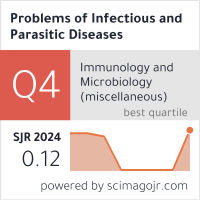CLINICAL CASE REPORT: PERTUSSIS INFECTION FOLLOWED BY A PARAPERTUSSIS INFECTION IN THE SAME CHILD
DOI:
https://doi.org/10.58395/faq0fx14Keywords:
PCR, diagnostics, B.pertussis, B. parapertussis, vaccinationAbstract
Whooping cough is a vaccine-preventable, acute respiratory disease caused by the gram-negative bacterium Bordetella pertussis. In recent years there has been a worldwide reccurrence of pertussis infection. The most vulnerable group in society are infants under one year of age, they are at the greatest risk of severe complications or even death. Whooping cough is usually associated with infection caused by B. pertussis, but Bordetella parapertussis can also cause pertussis-like symptoms. The disease is known as parapertussisл Clinical data alone are not sufficient to differentiate between the two infections. Modern, fast and reliable diagnostic is .needed. Bordetella holmesii, viral infections caused by RSV, adenovirus, etc. can present with pertussis-like symptoms and should be diagnosed and treated accordingly.
The aim of this study is to present a clinical case of a child with pertussis infection followed by parapertussis infection. To diagnose and differentiate the two infections, a real-time PCR molecular genetic method was used to detect the genes specific for the causative agents.
Pertussis vaccination does not protect against B. parapertussis infections, and cross-immunity between the two bacteria has not been observed. Therefore, in the presence of pertussis-like symptoms (paroxysms of persistent cough, vomiting after coughing), it is advisable to differentiate between B. pertussis and B.parapertussis infection, especially in populations with high pertussis vaccination coverage.
Downloads
References
ECDC. Pertussis - Annual Epidemiological Report for 2018
Shweta A, Manish G, Sonali P, Jitendra O, Sunil G, Dhiraj PD. Characterization of Bordetella pertussis Strains Isolated from India. Pathogens, 2022, 11, 794 https://doi.org/10.3390/pathogens11070794
Moosa F, Plessis M, Wolter N, Carrim M, Cohen C, Mollendorf C, Walaza S, Tempia S, Dawood H, Variava E, Gottberg A. Challenges and clinical relevance of molecular detection of Bordetella pertussis in South Africa. BMC Infectious Diseases, 2019, 19, Article number: 276 https://doi.org/10.1186/s12879-019-3869-7
Wu S, Hu Q, Yang C, Zhou H, Chen H, Zhang Y, Jiang M, He Y, Shi X. et al. Molecular epidemiology of Bordetella pertussis and analysis of vaccine antigen genes from clinical isolates from Shenzhen, China. Ann Clin Microbiol Antimicrob, 2021, 20:53 https://doi.org/10.1186/s12941-021-00458-3
Prygiel M, Mosiej W, Wdowiak K, Gуrska P, Polak M, Lis K, Krysztopa Grzybowska K, Zasada A. Bordetella pertussis isolates with different genetic profiles in murine model. Medical Microbiology and Immunology, 2021, 210:251–262
https://atlas.ecdc.europa.eu/public/index.aspx
CDC, 2021 Provisional Pertussis Surveillance Report
Valero-Rello A, Henares D, Acosta L, Jane M, Jordan I. Validation and Implementation of a Diagnostic Algorithm for DNA Detection of Bordetella pertussis, B. parapertussis, and B. holmesii in a Pediatric Referral Hospital in Barcelona, Spain. Detection and Identification Bordetella spp. by qPCR, Journal of Clinical Microbiology, 2019, 57, Issue 1 https://doi.org/10.1128/jcm.01231-18
B. parapertussis Infection: Public Health Recommendations. CDPH Immunization Branch/Division of Communicable Disease Control. California Department of Public Health. 2011
Dragsted D, Dohn B, Madsen J, Jensen J. Comparison of culture and PCR for detection of Bordetella pertussis and Bordetella parapertussis under routine laboratory conditions. Journal of Medical Microbiology, 2004, 53, 749–754. https://doi.org/10.1099/jmm.0.45585-0.
Liese J, Renner Cet all Clinical and epidemiological picture of B pertussis and B parapertussis infections after introduction of acellular pertussis vaccines. Arch Dis Child 2003;88:684–687
B. parapertussis Quicksheet. 2022. California Department of Public Health, Immunization Branch. www.cdph.ca.gov https://www.cdph.ca.gov/Programs/CID/DCDC/CDPH%20Document%20Library/Immunization/ParapertussisQuicksheet.pdf.
https://www.mh.government.bg/bg/informaciya-za-grazhdani/imunizacii/
Yinghua X,Yunqiang X, Qiming H, Rruifu Y, Shumin Z. Triplex real-time PCR assay for detection and differentiation of Bordetella pertussis and Bordetella parapertussis. APMIS 118: 685–691, 2010. https://doi.org/10.1111/j.1600-0463.2010.02644.x
Zhanga R, Lic Z, Gui-xia Lid G, Tiec Y, et al. A highly sensitive one-tube nested quantitative real-time PCR assay for specific detection of Bordetella pertussis using the LNA technique. Int J Infect Dis 2020; 93:224-230. https://doi.org/10.1016/j.ijid.2020.01.053
Downloads
Published
Issue
Section
License
Copyright (c) 2024 Nadia Brankova, Victoria Levterova, Magi Ivanova, Ivan Simeonovski, Мariya Malcheva (Author)

This work is licensed under a Creative Commons Attribution 4.0 International License.






